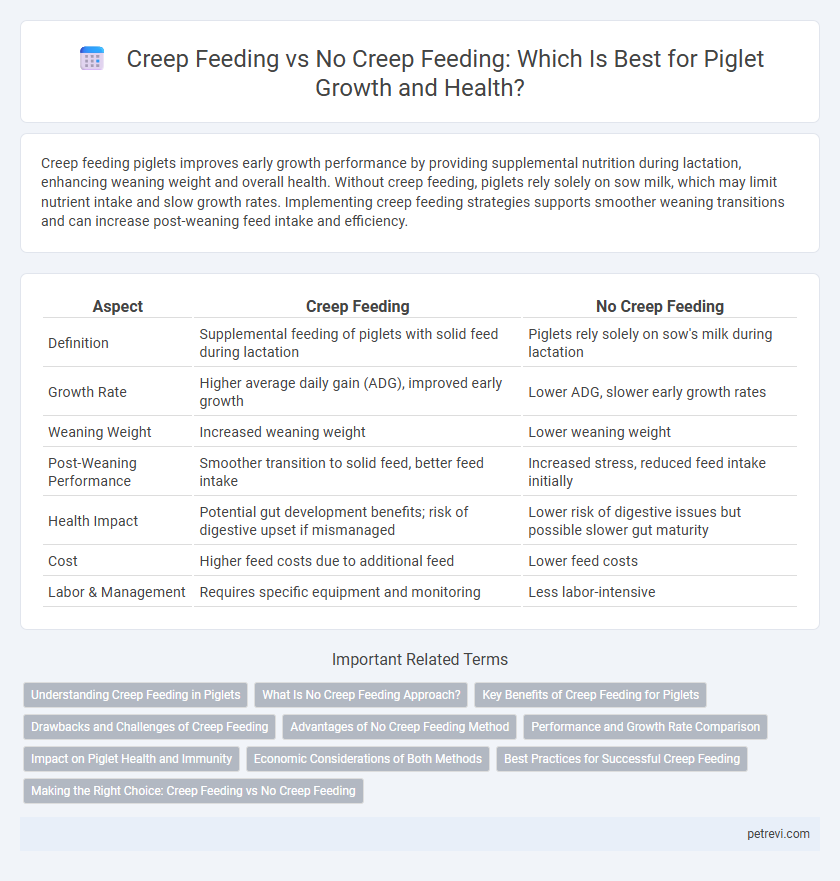Creep feeding piglets improves early growth performance by providing supplemental nutrition during lactation, enhancing weaning weight and overall health. Without creep feeding, piglets rely solely on sow milk, which may limit nutrient intake and slow growth rates. Implementing creep feeding strategies supports smoother weaning transitions and can increase post-weaning feed intake and efficiency.
Table of Comparison
| Aspect | Creep Feeding | No Creep Feeding |
|---|---|---|
| Definition | Supplemental feeding of piglets with solid feed during lactation | Piglets rely solely on sow's milk during lactation |
| Growth Rate | Higher average daily gain (ADG), improved early growth | Lower ADG, slower early growth rates |
| Weaning Weight | Increased weaning weight | Lower weaning weight |
| Post-Weaning Performance | Smoother transition to solid feed, better feed intake | Increased stress, reduced feed intake initially |
| Health Impact | Potential gut development benefits; risk of digestive upset if mismanaged | Lower risk of digestive issues but possible slower gut maturity |
| Cost | Higher feed costs due to additional feed | Lower feed costs |
| Labor & Management | Requires specific equipment and monitoring | Less labor-intensive |
Understanding Creep Feeding in Piglets
Creep feeding in piglets involves providing a specially formulated feed to nursing piglets before weaning, aimed at boosting growth rates and easing the transition to solid food. Research indicates that creep feeding can improve average daily gain and reduce weaning stress, enhancing overall piglet health and survival. Choosing the right creep feed composition, including high energy and digestible protein, is critical to maximizing its benefits.
What Is No Creep Feeding Approach?
No creep feeding approach for piglets involves relying solely on the sow's milk without providing supplementary solid feed during the lactation period. This method emphasizes natural nursing and can reduce feed costs but may result in slower early growth rates compared to creep-fed piglets. Pig producers using the no creep feeding approach often focus on optimizing sow nutrition and weaning management to support piglet development.
Key Benefits of Creep Feeding for Piglets
Creep feeding piglets enhances early growth rates by providing nutrient-dense feed that supports muscle development and immune function before weaning. This practice reduces stress during the weaning transition, leading to improved feed intake and overall health. Increased uniformity in piglet size at weaning also facilitates better performance in post-weaning stages and reduces mortality rates.
Drawbacks and Challenges of Creep Feeding
Creep feeding in piglets can lead to increased feed costs and digestive upsets due to abrupt dietary changes, negatively impacting gut health. It may also cause uneven growth rates as some piglets overconsume while others underconsume, leading to competition stress. Furthermore, reliance on creep feed can reduce sow milk intake, potentially impairing natural immunity transfer.
Advantages of No Creep Feeding Method
No creep feeding reduces feed costs and simplifies management by allowing piglets to rely solely on sow's milk during the early growth phase. This method promotes natural digestive development and strengthens the piglets' immune system by encouraging gradual adaptation to solid feed after weaning. It also minimizes the risk of digestive disorders commonly associated with early introduction of creep feed.
Performance and Growth Rate Comparison
Creep feeding significantly enhances piglet performance by providing additional nutrients that promote faster growth rates compared to no creep feeding. Studies demonstrate piglets receiving creep feed achieve higher average daily gains (ADG), improved weaning weights, and better post-weaning feed conversion ratios. No creep feeding often results in slower growth and lower overall performance due to limited nutrient intake during the critical pre-weaning phase.
Impact on Piglet Health and Immunity
Creep feeding significantly enhances piglet health by promoting early gut development and immune system maturation through improved nutrient intake, reducing post-weaning stress and mortality rates. Piglets without creep feeding often experience slower growth, weakened immunity, and higher susceptibility to infections due to limited access to solid nutrients before weaning. Studies show piglets receiving creep feed exhibit increased serum immunoglobulin levels and better resistance to common pathogens, supporting robust early-life health outcomes.
Economic Considerations of Both Methods
Creep feeding piglets increases early growth rates and can reduce weaning stress, potentially improving overall herd performance and market weight, but it involves additional feed costs and management labor. No creep feeding reduces immediate feed expenses and simplifies management practices, yet may result in lower pre-weaning growth and increased post-weaning nutritional stress, potentially affecting feed efficiency and long-term profitability. Evaluating the cost-benefit balance requires considering feed prices, piglet survivability, and regional market demands to optimize economic returns.
Best Practices for Successful Creep Feeding
Creep feeding enhances piglet growth by introducing nutrient-dense starter feeds before weaning, improving weight gain and gut development. Best practices include providing highly digestible, palatable feed low in fiber and ensuring easy access to feeders to minimize competition. Monitoring feed intake and maintaining hygiene prevent health issues and optimize the benefits of early nutrition during the critical pre-weaning phase.
Making the Right Choice: Creep Feeding vs No Creep Feeding
Creep feeding piglets enhances growth rates by providing early access to high-protein, energy-dense feed that supports digestive development and reduces weaning stress. Skipping creep feeding may result in slower weight gain and increased weaning challenges, but can lower feed costs and simplify management. Evaluating factors such as litter size, sow milk production, and feed costs ensures an informed decision between creep feeding and no creep feeding strategies.
Creep feeding vs No creep feeding for Piglets Infographic

 petrevi.com
petrevi.com